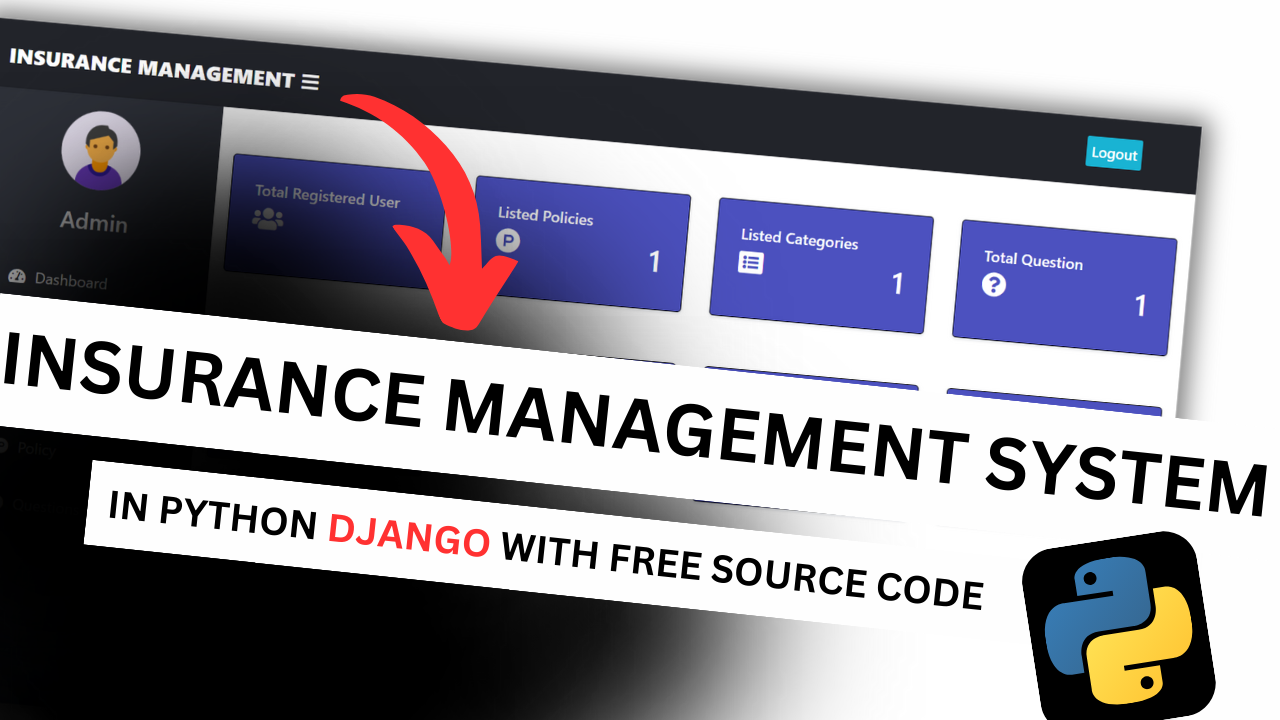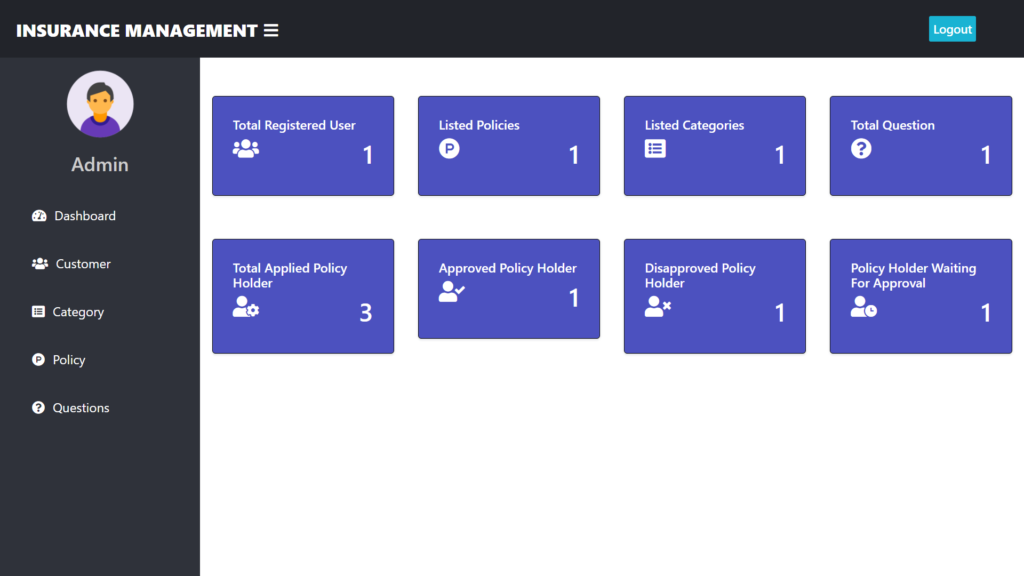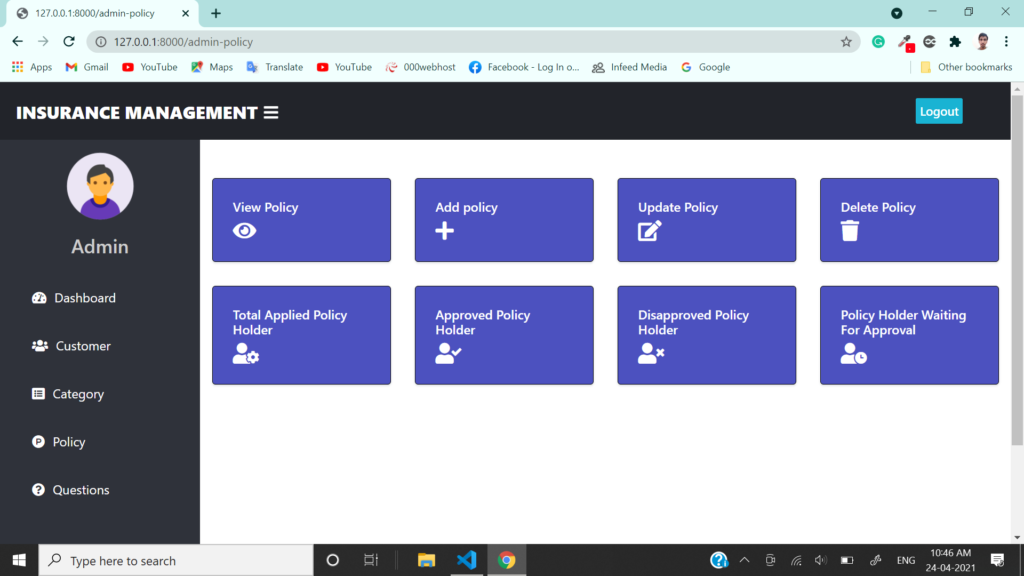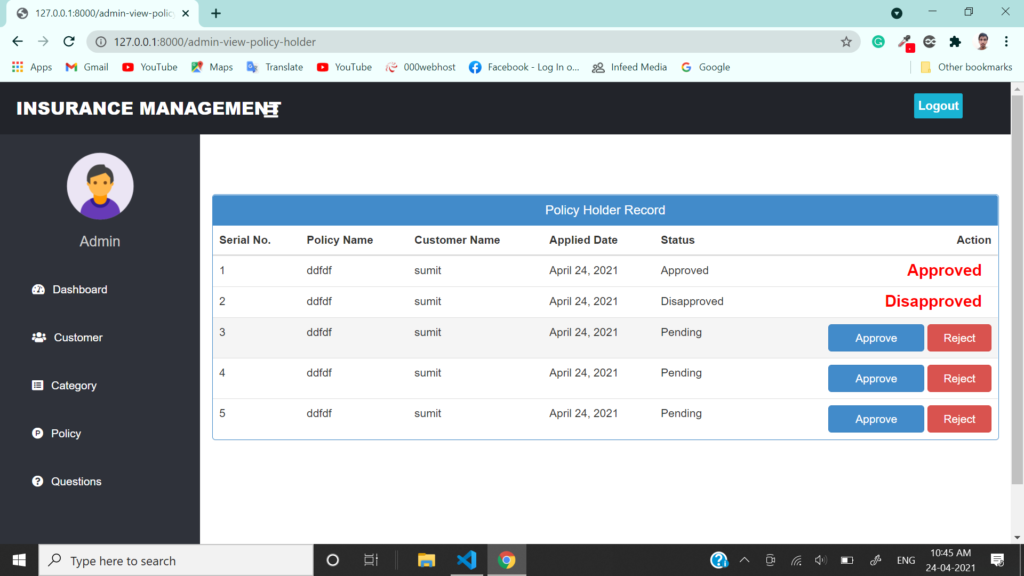

Insurance Management System in Python Django with Free Source Code
Insurance Management System in Python
Introduction
Project: Insurance Management System in Python
This system is a web-based application system with multiple users. It administers all of the customer’s insurance policies. Admin has more capabilities than the client. The createsuperuser command can be used to create an admin account. After logging in, admin can do CRUD operations on customers, policies, and categories. Additionally, the administrator can examine all registered users and respond to consumer questions.
About Insurance Management System in Python
This Python Django online insurance administration system project, in particular, focuses on dealing with insurance policies. In addition, the system displays all accessible categories and associated policies. Furthermore, the system provides for the management of client records. This project is clearly divided into two sections: Customer and Admin Panel.
Objective : Insurance Management System in Python
The objective of an Insurance Management System in Python is to create a software application that facilitates the efficient management of insurance-related processes. Such a system can be designed to streamline various aspects of insurance operations, providing functionalities for both insurance providers and clients. Here are key objectives for an Insurance Management System:
- Policy Management:
- Create, update, and manage insurance policies.
- Define different types of insurance policies (e.g., life insurance, health insurance, property insurance).
- Specify policy details such as coverage, premium amounts, and terms.
- Customer Management:
- Maintain a database of customers and their personal information.
- Manage customer policies, including policy history and status.
- Provide a user-friendly interface for customers to view and manage their policies.
- Claims Processing:
- Facilitate the submission of insurance claims by customers.
- Track and manage the entire claims processing lifecycle.
- Allow claims adjusters to review and process claims efficiently.
- Premium Calculations:
- Implement algorithms for premium calculations based on risk factors, coverage types, and other variables.
- Provide transparency to customers regarding premium amounts and factors affecting their costs.
- Agent Management:
- Manage insurance agents, including their commissions and performance.
- Assign policies to agents and track their sales.
- Reporting and Analytics:
- Generate reports on policy sales, claims processing, and financial performance.
- Provide analytics to help stakeholders make informed decisions.
- User Authentication and Authorization:
- Implement secure user authentication to protect sensitive information.
- Define roles and permissions to control access to various functionalities within the system.
- Notifications and Communication:
- Send automated notifications to customers for policy renewals, premium payments, and other important events.
- Facilitate communication between customers, agents, and the insurance provider.
- Document Management:
- Store and manage important documents related to policies, claims, and customer information.
- Ensure compliance with legal and regulatory requirements.
- Integration with External Systems:
- Integrate with external databases or services for data verification and validation.
- Connect with payment gateways for premium payments.
- Security and Compliance:
- Implement robust security measures to protect sensitive data.
- Ensure compliance with industry regulations and data protection laws.
How To Run The Project?
Python ,Django must be installed on your computer in order to execute this project. Once you’ve downloaded the project, take the following actions:
Step 1: Unzip or extract the file
Step-2: Navigate to the project folder, open Terminal, and install the dependencies by running the following command if necessary:
python -m pip install -r requirements.txt
py manage.py makemigrations
py manage.py migrate
py manage.py runserver
– Now enter following URL in Your Browser Installed On Your Pc :http://127.0.0.1:8000/
Insurance Management System in Python With Source Code is available for free download and use strictly for educational purposes! In addition, for the project demo, please see the video below:
Feature Insurance Management System in Python
- Customer Panel
- Admin Panel
- Apply for Insurance Policy
- Customer’s Policy History
- Ask Queries
- Manage Insurance Categories
- Manage Insurance Policies
- Customer Management
- Approve/Decline Policy Request
- List Policy Holders
- Query Management
### Admin
- – Admin account can be created using createsuperuser command.
- – After login, admin can view/update/delete customer
- – Can view/add/update/delete policy category like Life, Health, Motor, Travel
- – Can view/add/update/delete policy
- – Can view total policy holder, approved policy holder, disapproved policy holder
- – Can approve policy, applied by customer
- Can answer customer question
### Customer
- – Create account (no approval required by admin)
- – After login, can view all policy that are added by admin.
- – If customer likes any policy, then they can apply for it.
- – When customer will apply for any policy, it will go into pending status, admin can approve it.
- – Customer can check status of his policy under history section
- – Customer can ask question from admin.
📝 Scroll down and click the download button to get the free Invoice Generator In Django With Source Code project.
Outputs:-




Before Download This Project Please Check Complete Demo Video
Free Download Insurance Management System in Python Django with Free Source Code:
Click the Download Button Below
Note: Only for Educational Purpose
Download Project :-Click Here
Tags :-
- insurance management system in python
- insurance management system project in python
- what is insurance management system
- python insurance package
- python for insurance
- insurance policy management software
- insurance policy management systems
- best insurance management systems
- insurance management system project in python django
- erp system for insurance company
- insurance policy management
- mga systems insurance management system
- insurance management system github
- imanage python
- insurance management systems
- insurance management system project in java with source code
- insurance management system project in java
- l-systems python
- q-learning in python
- qms insurance
- r in insurance
- risk management python
- vml insurance programs
- insurance policy management system
- wm insurance
- wma insurance system
- py insurance








1 comment